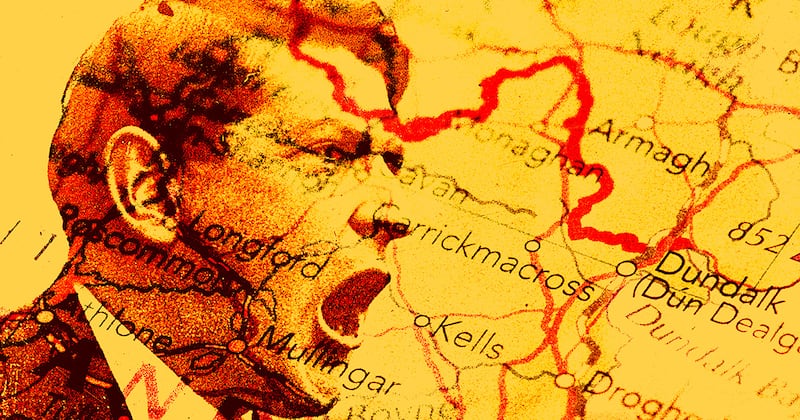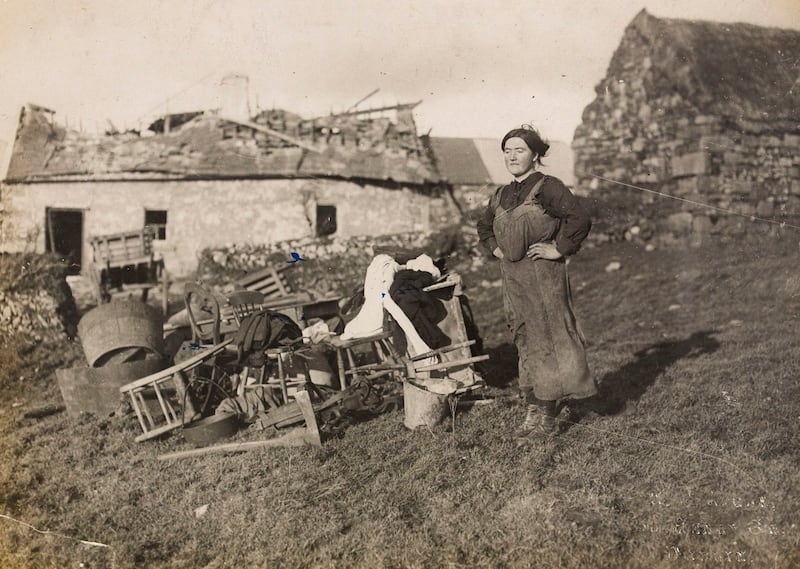On August 8th, 1918 the British army with the Australian and Canadian corps broke through the German lines during a morning of heavy fog at Amiens in north France. The British used advances in aircraft, tanks, which they pioneered, light machine guns and rifle grenades to spearhead an all-arms strategy that brought the Allied advance to victory in the first World War within 100 days.
At the end of the largest war in history to that date, the British Empire could put 3.8 million into the field and 70 fully-equipped divisions.
Yet less than three years later the British sued for peace against an army of poorly trained and even more poorly equipped volunteers.

Reflecting on the success of the IRA in bringing the British to the negotiating table, the future prime minister of India Jawaharlal Nehru observed: "A mere handful of young men and women, with the sympathy of their people behind them, fought against fantastic odds; a great and organised empire was against them. Ireland became one huge field of conflict where both parties vied with each other in violence and destruction; behind one of the parties was the organised strength of an empire, behind the other was the iron resolve of a handful of men".
Why did the British sue for peace in Ireland when they insisted on victory against a much more powerful foe in Germany?
The IRA was not victorious over Crown forces, but, by staying in the fight as long as it did, it effectively achieved the same thing.
This was despite being perennially short of guns. By the early summer of 1921, the IRA was under severe strain. More than 4,000 men were in jail including 19 brigade commanders and 90 battalion commanders.
According to the author Paul McMahon, the IRA was down to 2,000 active fighters and had only 569 rifles, 477 revolvers and 20 bullets per rifle. It was a pitiful arsenal to bear against an empire and there were many within the British security establishment, the Chief of the Imperial General Staff Field Marshal Sir Henry Wilson most notably, who believed one more push would silence the "murder gang" once and for all.
In June 1921 Nevil Macready, the General Officer Commanding (GOC) in Ireland, told the British cabinet that the rebels could be crushed with 20 more battalions, the imposition of martial law across the country, mass internments and executions. Yet even Macready recognised that, while this might ensure a temporary success, it would not solve the long-term problem – the British were no longer wanted in most of Ireland.
In any case neither the British government nor public had the stomach for such a campaign. The country was weary of war and had been continually involved in conflict since the outbreak of the first World War in August 1914.

The conduct of British forces in Ireland had brought international opprobrium on the country especially in the United States. There was also a realisation that the British could only achieve peace by waging all-out war against the civilian population bringing yet more opprobrium.
The British government had already conceded the principle of greater autonomy for Ireland through the Home Rule Act of 1912 which would have been implemented in 1914 were it not for the outbreak of the first World War.
That act was due to come into force after the Treaty of Versailles in June 1919 brought the war officially to an end, yet the issue of Ulster had still not been resolved. Exceptions had changed. The Irish were no longer content with limited autonomy within the United Kingdom, they wanted independence. The Ulster Unionists were reluctant home rulers, but came to the conclusion that having their own parliament was the best way to secure their own future.
The end of the first World War was not the end of British troop engagements abroad. British forces fought alongside the White army in the Russian Civil War, they were garrisoned in Upper Silesia trying to keep peace between the Poles and the Germans and on the west bank of the River Rhine.
The Egyptian Revolution in 1919 and the revolt in modern-day Iraq in 1920, a mandate Britain was given after the first World War, were serious challenges to the empire's authority. In India, the Amritsar massacre of April 1919 and its aftermath made Britain's biggest colony a perennial source of strife.
At home there were strikes in the coalmines and riots in the streets. In the summer of 1921 there were more than two million unemployed in the UK and another two million on strike. This was against the background of a rapid demobilisation of the post-war army and cuts in defence spending as Britain sought to pay its huge war debts.
Wilson laid out his difficulties in a memorandum in late 1920. Baldly put there were too many commitments and not enough troops.
"We discussed at length the parlous situation we are drifting into for want of a policy. We have 28 battalions in England and 40 in Ireland. When we have drafted from Ireland for India we shall be 4,500 men down on our present effectives. Macready will then ask for another 8-10 battalions. Then, if we go to martial law, Macready says he will want another nine battalions. Altogether we are now pretty near disaster."
Imperial overstretch
Coupled with Britain's imperial overstretch was a realisation especially among the British prime minister David Lloyd George and the Secretary for the Colonies Winston Churchill that Ireland had been too dominant an issue in British life for too long.
“It is a curious reflection to inquire why Ireland should bulk so largely in our lives. How is it that the great English parties are shaken to their foundations, and even shattered, almost every generation, by contact with Irish affairs?” Churchill said in the House of Commons while exhorting MPs to support the Anglo-Irish Treaty.
The great barrier to a settlement with Sinn Féin was the fate of Ulster. Once the Northern parliament was established, it opened the way for a more generous settlement with the South. A striking feature of British discussions was the absence of any sentimentality about letting Ireland go. Their chief concern was how the Irish departure would not set a bad example to the rest of the empire hence the insistence of Ireland remaining within the Empire the oath of Allegiance.
The behaviour of British forces in Ireland became a personal embarrassment to Lloyd George and Churchill. Lloyd George lost the friendship of the editor of the Manchester Guardian, CP Scott, over the policy of reprisals in Ireland. Churchill’s wife Clementine berated him over the “rough-fisted Hunnish ways” of the Black and Tans and Auxiliaries.
Churchill, who was half-American, was acutely aware of this when it came to seeking peace. “We are getting an odious reputation; poisoning our relations with the United States; it is in our power to go on and enlist constables and Black and Tans, but we should do everything to get a way to a settlement.”
The British response to the IRA campaign was to brand those involved as “murderers” and “assassins”, but that was for public consumption. Privately, the British government was impressed by the discipline and organisation of the IRA and its ability to endure. Privately too, British prime minister David Lloyd George recognised IRA men were not common garden murderers, but had considerable if not the majority support of the Irish public.
You will look hard to find any acknowledgement in the British government that Sinn Féin’s success in the 1918 general election in which they won 73 of the 105 seats available amounted to a democratic mandate for separation for Britain.
In May 1920 David Lloyd George sent a senior civil servant Mark Fisher to be his eyes and ears in the administration at Dublin Castle. Fisher was aghast at what he regarded as a "woodenly stupid and devoid of imagination" establishment who saw what they wanted to see and ignored the fact that behind the "murder gang" was an Irish public in sympathy with the goals of the IRA even if they did not always agree with the methods to achieve that aim.
Large-scale ambushes
Lloyd George acknowledged as much when he confided to his cabinet that “some day we will have to talk to the people who do represent Ireland”.
The British poured more troops into Ireland in 1921 and saturated the countryside. Improved tactics made large-scale ambushes more difficult for the IRA, yet the loss of so many men did not deter the IRA from prosecuting its campaign to the very end.
Despite the loss of 80 of its fighters in the Custom House debacle, the Dublin IRA mounted almost 100 operations against Crown forces in the capital in the month of June. Many of these operations were small-scale, road trenching, raids on mail and arson attacks against RIC barracks.
The cumulative effect was to sap the morale of the British to carry on. Macready warned in June 1921 that the whole of the army establishment would have to be replaced in Ireland by October.
The military tactician Basil Liddel Hart said in a guerrilla war a "multiplicity of minor coups and threats can have a greater effect than a few major hits by producing more cumulative distraction, disturbance and demoralisation among the enemy along with a more widespread impression among the population."
This was how the IRA’s endgame played out. When the ceasefire came on July 11th, 1921 it was the British who were most relieved. When told Crown Force fatalities in the War of Independence were 506, the British minister Herbert (HAL) Fisher opined they were lower than the quietest day on the Western Front.
The number of IRA dead between 1917 and 1941 was 491, according to the newly published book The Dead of the Irish Revolution. By contrast there are 4,000 Irishmen remembered on the Thiepval Memorial to the Missing alone and there are other memorials and graveyards along the Western Front where reposes the remains of more Irishmen than were killed in the revolutionary years.
The number of those who died for Irish freedom in the War of Independence was small, but their impact was huge.








